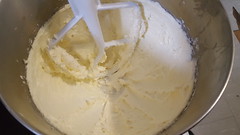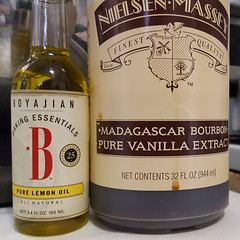2021-12-13: Updated with tweaks from my latest batch, the best yet!
I also added weight equivalents for most of the ingredients.
Living in New York City most of my life, I’m not in what one would think of as “maple country”. But the northeast is rich with sugarbushes – the managed groves and forests of maple trees from which sap is harvested and boiled down to make this nectar of the gods. And nearly every NYC Greenmarket (farmers’ market) has at least one farmer that sells maple syrup and other maple prodcuts, even if it’s not their primary business.
The key ingredient to this recipe is DARK maple syrup. If you only have regular/light maple syrup, to keep the mapley flavor, you can use that and add 1/8 teaspoon of real maple flavoring, available from specialty baking suppliers.
The extra spices are optional. I found the ginger and cloves enhance the mapleness of these cookies.
Ingredients
Double, as needed. Do not attempt to halve this recipe; it calls for one egg.
- 1/2 cup (1 stick) unsalted (“sweet”) butter, softened to room temperature
- 1/2 cup vegetable shortening, softened to room temperature
- 1 cup (213 grams) dark brown sugar
- 1 cup (312g) DARK maple syrup
- 1 Tablespoon vanilla extract (I really like vanilla. Original recipe calls for 1 teaspoon)
- Optional: 1/8 teaspoon real maple flavor, either to make up for lack of dark maple syrup, or to boost the flavor
- Optional: ¼ teaspoon ginger
- Optional: 1/8 teaspoon ground cloves
- Optional: ½ teaspoon salt (I nearly always omit this from my baking. These cookies don’t need it.)
- 1 large egg
- 1 teaspoon baking soda
- 4 cups (480g) pastry flour, or pastry blend flour, sifted to remove lumps.
- Optional: maple sugar or white granulated sugar, for decoration
Preparing the Dough
- Cream the butter and brown sugar together until light and fluffy.
- Add the maple syrup, vanilla, and your chosen flavorings.
- Scrap down the bowl, blend thoroughly, and taste to adjust, as needed.
- Add the egg and mix thoroughly.
- Add the baking soda and mix thoroughly.
- Add the flour gradually, blending at slower speed, until all flecks of flour are gone.
Chill the Dough
This is a very soft dough. Chill the dough, covered tightly to keep out air, for at least two hours. It’s even better overnight.
Baking
- Preheat the oven to 375F.
- Line a baking sheet with parchment paper.
- Scoop out tablespoon sized balls of dough.
- If you want, roll them in the sugar.
- Set them far apart on the cookie sheet. They will spread.
- Bake for 11 minutes.
- Let the cookies cool on the sheet until they are firm enough to remove.
Notes and Tips
- You can use all butter, if you don’t have shortening, or prefer not to use it. This is already a very soft dough, so you may need to use less maple syrup to compensate for the increased moisture from the butter.
- If you double the recipe, 2T = 1/8C for the vanilla.
- Real/natural maple flavor can be over-powering. So taste the batter before adding the eggs, and adjust as needed. Even when doubling the recipe, 1/8 teaspoon is likely enough.
- The original recipe called for 2 teaspoons of baking soda, and the cookies came out more poofey/cakey than sugary/crispy. If you prefer your cookies that way, you may want to experiment with increasing the baking soda by 1/2 teaspoon.
- This comes out as such a soft dough, it can be difficult to work with when forming the cookies. I want to try substituing some of the brown sugar with maple sugar. I would probably need to also substitute some of the baking soda with baking powder to compensate for the reduced acid.
- Pastry flour has a lower gluten content than others and makes for a more tender cookie.You can use all-purpose white flour, or even white whole wheat flour, instead.
Related Content
Links
This recipe is adapted from “Maple Cookies” from AllRecipes.


























